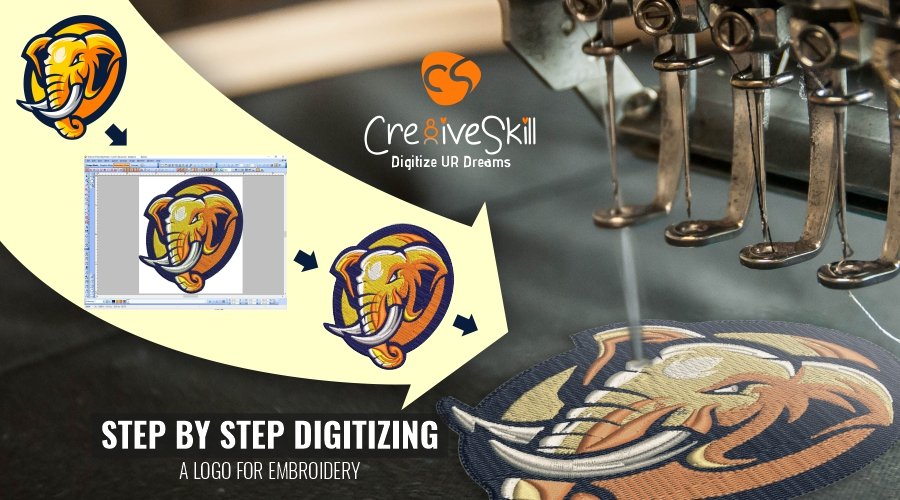Specialist Digitizing for Embroidery: High-Quality Designs
Specialist Digitizing for Embroidery: High-Quality Designs
Blog Article
Simplifying the Art of Needlework Digitizing: Step-by-Step Overview
As technology proceeds to breakthrough, the digitization procedure has come to be a lot more easily accessible, enabling enthusiasts to bring their elaborate layouts to life with ease. In this guide, we will unwind the intricacies of embroidery digitizing, damaging down each step carefully to improve the procedure and encourage both beginners and experienced embroiderers alike.
Understanding Embroidery Digitizing Software
Embroidery digitizing software program acts as an important tool for transforming complex layouts right into electronic layouts compatible with needlework devices, helping with accurate sewing and customization. This specialized software application permits customers to import different photo data layouts, such as JPG or PNG, and transform them right into embroidery machine-readable formats like DST, EXP, or PES - Digitizing for Embroidery. By making use of features like stitch editing and enhancing, rug choices, and thread color choice, digitizing software makes it possible for users to manage every element of the style process
Moreover, progressed embroidery digitizing software application uses devices for creating complex designs, adjusting stitch density, and integrating intricate details. Individuals can also preview the layout prior to sewing it out, ensuring accuracy and lessening mistakes. Furthermore, lots of software program programs provide automated attributes that aid enhance the digitizing procedure, saving time and effort.
Understanding the capabilities of needlework digitizing software application is important for attaining top quality lead to needlework tasks. By grasping this tool, embroidery enthusiasts and professionals can release their creative thinking and bring detailed styles to life with accuracy and efficiency.

Choosing the Right Style File
After familiarizing yourself with the capabilities of embroidery digitizing software application, the following critical action in the procedure is picking the best style apply for your task. Digitizing for Embroidery. When picking a design data for needlework digitizing, it's important to take into consideration the complexity of the design, the size of the last item, and the kind of fabric you will certainly be collaborating with
For intricate designs with great details, a high-resolution picture or vector file is recommended to ensure that the embroidery equipment can accurately recreate the style. In addition, the size of the last product plays a considerable duty in selecting the right style file. Bigger designs might need higher resolution documents to maintain clearness and intensity.
Additionally, the type of fabric you will be stitching on influences the selection of style documents. Various fabrics might require adjustments in the layout file to guarantee that the stitches are properly aligned and the style appears as planned. By meticulously selecting the right design data based upon these aspects, you can establish yourself up for an effective needlework digitizing process.
Digitizing Devices and Methods
Using specialized software and accuracy methods, digitizing site tools are necessary in transforming complex styles into embroidery-ready data. Embroidery digitizing software program, such as Wilcom, Hatch, or Embrilliance, supplies the required platform to transform artwork right into stitch information. These programs use attributes like stitch editing, padding choices, useful link and lettering devices to guarantee the style converts flawlessly onto fabric.
One of the crucial methods in digitizing is producing a clear course for the embroidery device to follow. This entails digitizing each element of the style with precision, identifying stitch types, densities, and directions. By utilizing devices like digitizing tablet computers or software-specific plugins, embroiderers can attain a high degree of accuracy in their digitized styles.
Moreover, grasping the art of rug sewing is crucial for producing top quality embroidery. Underlay sewing stabilizes the fabric and produces a foundation for the design, ensuring that the last product is both visually attractive and lasting. By comprehending these digitizing devices and techniques, embroiderers can raise their craft and bring detailed designs to life with precision and look at more info efficiency.
Personalizing Stitch Kinds and Instructions
The option of stitch kinds can considerably impact the overall appearance and texture of the embroidered design. By tactically integrating these stitch types, embroiderers can accomplish depth and dimension in their styles.
Additionally, the instructions of stitches plays a critical function in enhancing the visual charm of the last needlework. Varying stitch instructions can include appearance, emphasize details components, and produce visual passion. As an example, transforming the angle of stitches can imitate motion or natural patterns like hair or plumes. By try out different stitch angles and patterns, embroiderers can bring their layouts to life with remarkable detail and details. Mastering the art of personalizing stitch types and directions equips embroiderers to release their creativity and elevate the quality of their job.
Testing and Refining Your Digitized Style
To make certain the accuracy and top quality of your digitized layout, detailed testing and improvement are crucial steps in the needlework digitizing procedure. Once you have completed the digitization of your style, it is important to examine it before continuing with the actual needlework. Testing allows you to identify any potential concerns such as string breaks, stitch density troubles, or design distortions that may affect the result.

After screening, it is necessary to improve your digitized design based upon the responses from the test sew-out. This might entail tweaking sew settings, changing densities, or making changes to the general style to attain the preferred result. By iterating through testing and improvement, you can tweak your digitized layout to perfection before moving on with the real needlework procedure.
Conclusion
To conclude, grasping the art of embroidery digitizing needs a comprehensive understanding of the software program, selecting the ideal design file, making use of digitizing tools and techniques, customizing stitch types and directions, and screening and fine-tuning the digitized style. By following these actions, embroiderers can streamline the digitizing procedure and create top notch stitched designs with accuracy and effectiveness.
Report this page